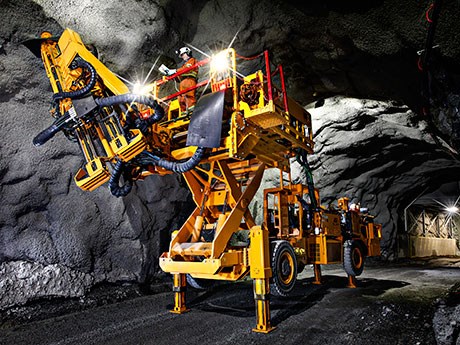Sandvik, MacLean Engineering selected to supply battery-powered equipment
Goldcorp has announced plans to develop an all-electric mine at its Borden Lake deposit near Chapleau, 200 kilometres southwest of Timmins.
Goldcorp’s 2015 acquisition of the project from Probe Mines was touted as one of the best new development assets in the industry.
Since mining is relatively new to this part of northeastern Ontario, Marc Lauzier, mine general manager of Goldcorp’s Porcupine Gold Mines (PGM) division in Timmins, said his team is taking extra care to educate everyone and gather residents’ feedback in developing a “green mine” that will have minimal environmental impact.
“Borden is a bit unique,” he said. “It’s a new mine and it’s in a pristine area. So we’re trying to minimize noise, dust and take the smallest possible footprint. Everything we’re doing revolves around that.”
In 2015, Goldcorp reported Borden Lake contained an indicated resource of 1.6 million ounces of gold. Exploration continues as the deposit remains open at depth.
A pre-feasibility study is underway, which should be completed by year’s end, with a feasibility study slated to start soon after.
Construction of the portal will start in February. The ramp will be driven into the deposit to extract a 30,000-tonne bulk sample in 2018. Commercial production starts in mid-2019.
While the study work goes on, Goldcorp will be applying for provincial and federal permits for commercial operations, said Lauzier.
“Right now, we’re permitted for advanced exploration and when that’s complete we hope that the timing will be such that we’ll get our permanent permits and we’ll continue on.”
The concept of all-electric mine had suppliers like Sandvik Mining and MacLean Engineering crowing about their involvement with the “world’s first 100 per cent diesel-free hard rock mine” at MINExpo in September.
Sandvik will be supplying Borden with two electric DD422iE twin-boomed jumbos as well as loaders and trucks, while MacLean is providing two battery-powered 975 scaler-bolters for ground support.
MacLean’s fleet electrification program was initiated in 2015 and by 2017 will be able to offer customers a battery option on all units across the company’s ground support, ore flow and utility vehicle product lines.
The Sandvik jumbo recharges during the drilling cycle using the mine’s existing electrical infrastructure.
The loaders will be tethered to begin with, said Sandvik spokesman Kerry Falk, but the ultimate objective is to supply Goldcorp with untethered equipment.
“We’ll be the first to try this jumbo, as far as I know,” said Lauzier. “Some of this gear has already been tested at other sites. Sandvik is providing us with the majority of the gear and there’s some utility equipment that we’re purchasing from other companies.”
Goldcorp has experimented with battery-powered vehicles at its other mines to eventually replace its diesel fleet as underground mine ventilation is being pushed to its capacity at these sites.
“What’s different about Borden is that we’re ordering all-electric and battery gear with the goal of using no diesel equipment,” said Lauzier.
“You’re going to design your mine according to the equipment that you’re running and because you’re running an electric mine, you’re going to have less ventilation requirements.”
Buying electric equipment means more upfront capital costs, but the payoff is down the road on operating costs and efficiencies by not burning fuel, and with the savings on ventilation and power.
“It’s cheaper to charge a battery than it is to run a fan,” said Lauzier.
Those savings will be identified in the more detailed mine feasibility study.
The possibility of generating their own power is being explored to reduce their reliance on the provincial power grid, he said.
The addition of a new mine stands to benefit the longevity of Goldcorp’s Timmins mines and mill operations.
“It’s a great opportunity for PGM,” said Lauzier. “The mine here has been around for 110 years. I’ve got a very hungry mill that can mill up 12,000 tonnes per day and because of its size, the cost of milling here is very cheap.
“It makes trucking the ore to Timmins and milling it here economic rather than having to build a mill there and incurring that capital cost.
“There are a lot of shared services we can provide between the two sites. If we were to find a lot more ore, there would be a point where it would trade-off and it would make a lot more sense to build a mill there, but we certainly don’t have enough ore proven up to justify those expenses.”
Besides meeting with the Township of Chapleau, Goldcorp has been consulting with the Chapleau Cree, Chapleau Ojibway and Brunswick House First Nations with whom they’ve struck memoranda of understandings (MOU). They are currently in the process of negotiating an MOU with the Michipicoten First Nation.



